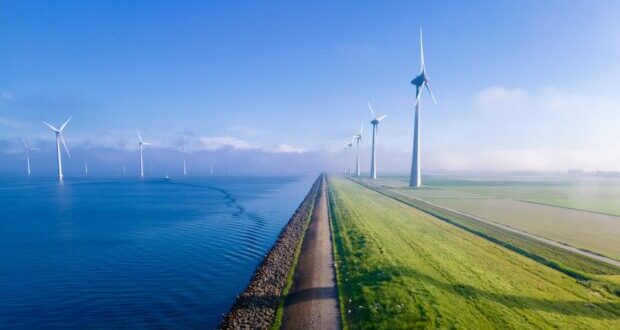The Inflation Reduction Act (IRA) is spurring a land rush for development sites and giving impetus to clean energy equipment manufacturing in the United States, which could see annual renewable capacity additions triple to 110 gigawatts (GW) in ten years, according to Wood Mackenzie.
Despite supply-chain and tariff challenges unrelated to the IRA and despite the fact that developers are still waiting for clarity on some of the IRA provisions, the benefits of the landmark climate law have started to manifest themselves, clean energy associations say.
“There are still challenges that remain, but overall, low-cost renewables present a major opportunity for investment, and we project annual capacity additions in 10 years to nearly triple what they are now,” Chris Seiple, Vice Chairman of Wood Mackenzie’s Power & Renewables group, said at the RE+ conference in Las Vegas this week, as carried by Electrek.
The IRA, passed in August last year, has nearly $370 billion in climate and clean energy provisions, including investment and production credits for solar, wind, storage, critical minerals, funding for energy research, and credits for clean energy technology manufacturing such as wind turbines and solar panels.
Wind, solar, energy storage, and manufacturing to support those industries are all set to boom in the coming years, analysts and industry associations say.
Despite the passage of the IRA, 2022 wasn’t a very successful year for U.S. renewable capacity additions—trade restrictions and supply chain uncertainties hit solar installations, while wind capacity additions suffered from regulatory, supply chain, and interconnection challenges.
The U.S. installed more than 25 GW of wind, solar, and storage last year, but total clean power installations declined in 2022 for the first time in five years, the American Clean Power Association (ACP) said in a report earlier this year.
Going forward, the U.S. clean energy market is about to shake off many of the uncertainties from 2022, according to analysts.
“The US markets for wind and solar PV contracted last year due to restrictive trade measures and supply chain constraints, but annual additions for both technologies are set to increase by around 40% in 2023, with solar PV setting a new record,” the International Energy Agency (IEA) said in its Renewable Energy Market Update report in June.
“The current forecast is underpinned by existing tax incentives, while the Inflation Reduction Act will show its full effect after 2024, providing unprecedented certainty for renewable energy projects until 2032,” the agency added.
The solar industry in the United States expects to install a record-high 32 GW of new capacity this year, with additions surging by 52% from 2022, the Solar Energy Industries Association (SEIA) and Wood Mackenzie said last week.
Total operating solar capacity in the U.S. is expected to rise from 153 GW today to 375 GW by 2028, Wood Mackenzie predicts.
“Despite the near-term challenge of navigating IRA guidance, the growth outlook for the US solar industry is strong,” Michelle Davis, Head of Global Solar at WoodMac, said, noting that the industry has yet to see the full benefits of the IRA.
Apart from installations, solar manufacturing is also set for a boom. Since the IRA became law, the U.S. has seen more than 59 solar manufacturing announcements.
“If all of these facilities come online by 2026, they would have the potential to meet 250% of our nation’s current demand for solar,” SEIA president and CEO Abigail Ross Hopper said at the RE+ conference this week.
The association expects the U.S. solar and storage industry to add $565 billion to the economy over the next decade, creating another half a million jobs along the way, as a result of the IRA, Hopper added.
Between August 2022 and July 2023, more than $270 billion in capital investment was announced for utility-scale clean energy projects and manufacturing facilities in the United States, ACP said in a report last month. This exceeds the combined clean energy investments made over the previous eight years.
In the last year alone, $271 billion in investment and nearly 185 GW worth of projects were announced, as well as 83 new or expanded utility-scale clean energy manufacturing facilities, the association noted.
“America’s manufacturing centers are competing to meet new clean energy demand with a new domestic wind, solar or storage manufacturing facility announced every four days,” said ACP CEO Jason Grumet.
“The only question is whether government policy will allow us to build the clean energy infrastructure in time to seize this opportunity.”

offshore windmill park with clouds and a blue sky, windmill park in the ocean aerial view with wind turbine Flevoland Netherlands Ijsselmeer. Green energy ; Shutterstock ID 2064279029; purchase_order: Energy Voice; job: Brian Wilson col May 23
 Iran Energy News Oil, Gas, Petrochemical and Energy Field Specialized Channel
Iran Energy News Oil, Gas, Petrochemical and Energy Field Specialized Channel



